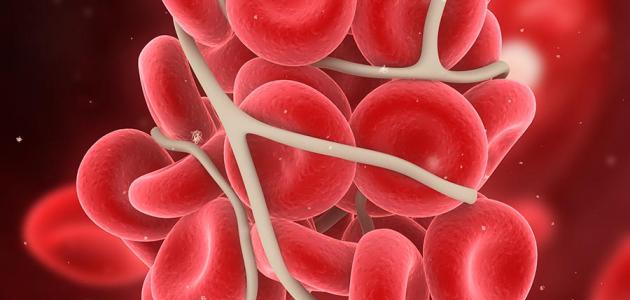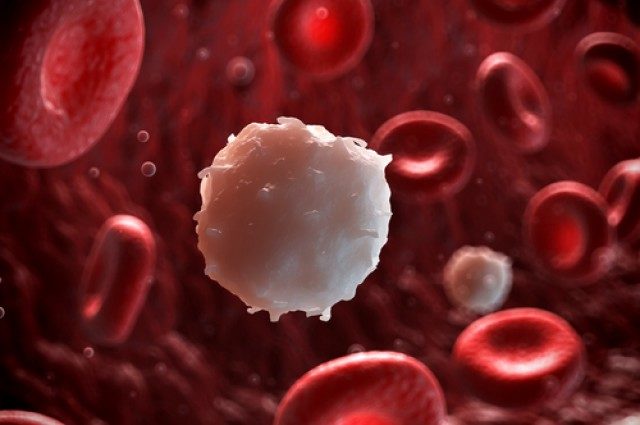Leukemia, or blood cancer, occurs in a very subtle and insidious way. Here are the signs and symptoms to watch more closely.
Leukemia definition?
Leukemia is a cancer of the blood and bone marrow resulting in an abnormal production of certain blood cells. As malignant cells take over healthy cells, blood functions begin to deteriorate and are then observed physical symptoms. The disease can progress rapidly if you are suffering from an acute form, or it can gradually evolve and develop into chronic leukemia, according to the Canadian Cancer Society. Whatever type you have, react quickly if you watch some of these subtle signs and symptoms of leukemia and consult your doctor.

Types of leukemia
There are several types of leukemia. We can classify them according to the speed of evolution of the disease (acute or chronic) and in stem cells of the bone marrow from which they develop (myeloid or lymphoblastic). Leukemia usually refers to cancers of the white blood cells (lymphocytes and granulocytes, cells responsible for immunity), although some rare cancers can affect the red blood cells and platelets.
Acute leukemia
The abnormal blood cells are immature (= blasts). They do not perform their normal function and multiply rapidly, so that the disease is changing rapidly too. The treatment is aggressive, and it should be applied as soon as possible.
Chronic leukemia
The cells involved are more mature. They multiply more slowly and remain functional for some time. Certain forms of leukemia can go unnoticed for many years.
Myeloid leukemia
It affects both granulocytes and blood stem cells present in the bone marrow. They produce white blood cells (myeloblasts) abnormal. There are two types of myeloid leukemia:
- Acute myeloid leukemia (AML)
This form of leukemia begins suddenly, often within days or weeks. AML is the most common form of acute leukemia in adolescents and young adults. AML can occur at any age but is most likely to develop in adults 60 years and older. - Chronic myeloid leukemia (CML)
Chronic myelogenous leukemia is also called chronic myelocytic leukemia or chronic leukemia grainy. This type of leukemia develops slowly over months or even years. Symptoms of the disease manifested as the number of leukemia cells in the blood or bone marrow increases. This is the form of the most common chronic leukemia in adults between 25 and 60 years. They sometimes require treatment for several years.
Lymphoblastic leukemia
Lymphoblastic leukemia affects lymphocytes and lymphoblasts. There are two types of lymphoblastic leukemia:
- Acute lymphoblastic leukemia (ALL)
This form of leukemia begins suddenly and rapidly changing in a few days or weeks. It is also called acute lymphocytic leukemia or acute lymphocytic leukemia is the most common form of leukemia in young children. There are several subtypes of this form of leukemia. - Chronic lymphocytic leukemia (CLL)
This form of leukemia is mostly found among adults, especially between 60 and 70 years. Sufferers may have no or very few symptoms for years and have a phase in which the leukemia cells grow rapidly.

The causes of leukemia
The causes of leukemia are not well understood. Scientists agree on the fact that the disease is a combination of genetic and environmental factors.
Prevalence
In Canada, a man of 53 and a woman of 72 diagnosed with leukemia during their life. In 2013, an estimated 5,800 Canadians were achieved. (Canadian Cancer Society). In France, leukemia affects about 20,000 people each year. Leukemia represents about 29% of cancers in children, 80% are acute lymphoblastic leukemia (ALL).

Diagnosis of leukemia
- Blood test: The analysis of a blood sample to detect whether the levels of white blood cells or blood platelets are abnormal, suggesting leukemia.
- Biopsy of the bone marrow: A bone marrow sample removed from the hip to detect certain characteristics of leukemic cells, which are then used to provide options for the treatment of disease.

The Main Symptoms of leukemia
Symptoms of the disease vary depending on the type of leukemia:
Symptoms of acute leukemia are generally nonspecific and resemble those of other diseases such as influenza. They can appear suddenly in a few days or weeks. Symptoms of chronic leukemia in the early stages of the disease are very diffuse or nonexistent. The first symptoms appear gradually:
- Fever, chills, or headaches
- Weakness or persistent fatigue
- Anemia, or shortness of breath, pallor, palpitations (rapid heartbeat), dizziness
- Frequent infections (lung, urinary tract, the gingival contour of the anus, herpes or cold sores)
- Loss of appetite
- Sore throat
- Weight loss
- Swollen glands, liver or swollen spleen
- Bleeding (nose, gums, heavy periods) or easy bruising
- Small red spots on the skin (petechiae)
- Excessive sweating, especially at night
- Pain or tenderness in the bone
- Vision disorders
Among the symptoms of leukemia are fatigue and weakness. Fatigue and weakness are the most common signs of all types of leukemia; these symptoms are often caused by anemia, a deficiency of red blood cells, which only aggravates physical exhaustion. According to the type of leukemia, whether it is chronic or acute, symptoms vary from mild fatigue to extreme physical weakness, but in all cases, the disease will only get worse with time. “It is a disease that continues to grow.
Shortness of breath may also be a symptom of leukemia. More patients become weak and tired, and they are more likely to feel out of breath because of anemia or, more rarely, masses that develop in the lungs. People with leukemia are breathless. Walking across a room can be difficult. Shortness of breath can also be a symptom of lung cancer.
excessive or Spontaneous bruising: The bruising arising from any physical trauma can be a sign of leukemia; the unusual bruising is consecutive to a low platelet count or bleeding disorders. “These bruises can appear anywhere, with a predilection for the extremities – arms and legs,”
unusual bleeding: As bruising, unusual bleeding from the nose, gums, digestive tract, lungs, or the head are sometimes due to low platelet counts and coagulation disorders, which may indicate acute leukemia.
Petechiae (small red spot under the skin caused by bleeding): it is as if someone had painted small red spots with a pencil .these spots, which may go unnoticed because of their size, their location in the lower extremities, and because they are painless, indicate a low platelet count. We state that Petechiae are often found around the ankles because of gravity, body fluids accumulate in the lower legs all day long.
Gums are swollen and hypertrophied: Although few patients with acute leukemia showed an increase in the size of the gums, known as gingival hyperplasia, this remains one of the most obvious signs of the disease. If you have a leukemia patient, you always look to see if his mouth were swollen gums. The gums look swollen, and you still have a strange stiffness in your mouth.

Leukemia: People at risk
- People with genetic disorders. Certain genetic abnormalities play a role in the development of leukemia. For example, Down’s syndrome is associated with a high risk of leukemia.
- People with blood disorders. Certain blood disorders such as myelodysplastic syndromes (= disease of the bone marrow), may increase the risk of leukemia.
- People who have a family history of leukemia.
Leukemia: Risk factors
- Having undergone treatments against cancer: Some types of chemotherapy and radiotherapy received for different types of cancers may increase the risk of developing certain forms of leukemia.
- Exposure to high levels of radiation: People exposed to high doses of radiation, such as survivors of a nuclear accident, have an increased risk of developing leukemia.
- Exposure to chemicals: Exposure to certain chemicals, such as benzene (a product of the chemical content in gasoline), increases the risk of certain types of leukemia.
- Tobacco: Cigarette smoking increases the risk of certain types of leukemia.

Prevention of leukemia
Can we prevent leukemia?
Studies show that there would be a link between childhood leukemia, and certain environmental factors (radioactive radiation, direct exposure to certain pesticides, prolonged exposure to electromagnetic fields, alcohol, cigarette smoke). However, further research is needed to confirm these effects.

medical treatments for leukemia
The purpose of treatment for leukemia is to eliminate the malignant cells without affecting normal cells in the bone marrow. Several studies are underway to develop the best possible treatments. Depending on the type of leukemia, the patient’s age, and health, several treatment options are available. Treatment usually comprises several stages including:
chemotherapy
Chemotherapy is a systemic therapy that circulates throughout the body and is designed to destroy cancer cells and reduce the production of blood cells to normal. Different cancer (cytotoxic) drugs are used depending on the type of leukemia.
Radiotherapy
Radiation treatment employs radiation or high-energy particles to destroy cancer cells. This technique is used to treat or prevent the spread of the disease to the central nervous system and in preparation for a stem cell transplant.
Targeted therapy
Some medications are addressing specific vulnerabilities of cancer cells. For example, in chronic myeloid leukemia, a drug inhibitor of tyrosine kinase (imatinib, Gleevec Canada, Glivec in France and Belgium) has become a standard treatment, particularly early in the disease. It allows periods of remission of more than five years.
Graft or bone marrow or autologous stem cell transplantation
After chemotherapy and radiation therapy, the patient receives a bone marrow injection of stem cells that allow reforming the bone marrow. Stem cells can come from a donor or the patient’s own (autologous). This technique is used treatment for persons under 55 years.

Supportive therapy
Different drugs can be administered to control complications of treatments, such as antibiotics and antifungal agents. They fight infections that happen when the blood count is low. Besides, some drugs reduce the high levels of certain chemicals in the blood, leukapheresis to reduce the number of white blood cells.
Monitoring after treatment
Patients who got treatment against leukemia should be monitored regularly for about five years, even if they have no signs of illness.


